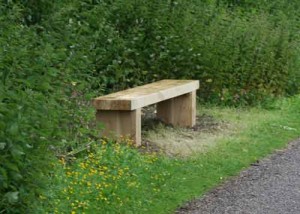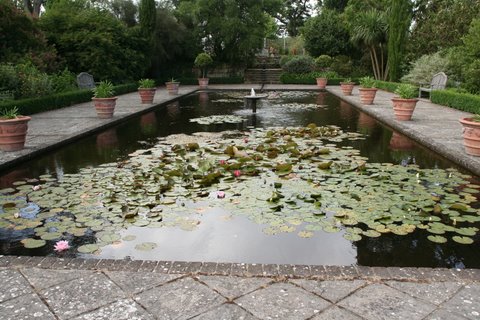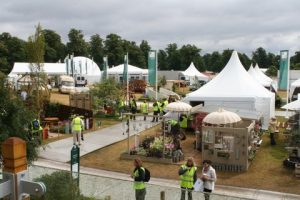 Wakehurst Place in West Sussex, England, is managed by the Kew Royal Botanic Garden. The valley is a beautiful rhododendron garden and the lake at end of the valley is very beautiful. But the horticultural section of the garden is amateurish. The horticultural standard is fine but the design standard is, well, too horticultural. The bog garden is a case in point. It was made by the Horticultural Team between 2001 and 2003. The planting is OK but the construction design is a disgrace to the name Kew. As the photograph shows, there is a lumpen retaining wall with ‘crawling snail’ cement pointing. As my granny would have said ‘Its horrid’. And look at the bottom edge of the photograph. There is a cheap gray plastic pipe which is used as a ‘water feature’. Even toilets don’t have water features like this. They employ plumbers. Wakehurst place should employ an expert garden designer to make occasional visits and give a professional opinion, much as Dame Sylvia Crowe used to do for the UK Forestry Commission.
Wakehurst Place in West Sussex, England, is managed by the Kew Royal Botanic Garden. The valley is a beautiful rhododendron garden and the lake at end of the valley is very beautiful. But the horticultural section of the garden is amateurish. The horticultural standard is fine but the design standard is, well, too horticultural. The bog garden is a case in point. It was made by the Horticultural Team between 2001 and 2003. The planting is OK but the construction design is a disgrace to the name Kew. As the photograph shows, there is a lumpen retaining wall with ‘crawling snail’ cement pointing. As my granny would have said ‘Its horrid’. And look at the bottom edge of the photograph. There is a cheap gray plastic pipe which is used as a ‘water feature’. Even toilets don’t have water features like this. They employ plumbers. Wakehurst place should employ an expert garden designer to make occasional visits and give a professional opinion, much as Dame Sylvia Crowe used to do for the UK Forestry Commission.
Category Archives: Garden Visiting
Long grass and mown grass
The English summer of 2008 has had an unusually good mix of sun and rain. Perhaps a bit too much rain actually, but it has been very good for grass and it is a pleasure to see how many more gardens make a feature of the contrast between long grass and mown grass. Twenty years ago one only saw this effect at Great Dixter and in gardens which made a feature of daffodils or bluebells or another favoured flower. Today you can even find patterns of mown and unmown grass in London’s parks – the impetus to this came from David Goode at the Greater London Council and from the Urban Wildlife Group which Chris Baines co-founded. The popularity of grass in gardens has also been influenced by Piet Oudolf and a general enthusiasm for planting ornamental grasses in gardens.
National Trust Gardens
 When Dame Jennifer Jenkins was appointed to chair the UK National Trust she commented that the main criticism of the gardens they manage is that ‘They are all the same’. It is not quite true but they do have an alarming similarity. This was brought home by visits to some visits to Yorkshire gardens this year. Studley Royal, run by the National Trust, has not had the ‘curse of Sissinghurst’ laid upon it. Of course I love Sissinghurst and of course it attracts busloads of visitors, but I do not want to see England’s historic gardens getting ever more like Sissinghurst. Studley Royal retains its independent dignity but it IS getting more National Trusty. Perhaps the paths are being too well kept; perhaps too many seats are appearing; perhaps that terrible Visitor Centre has an existence outside my drawer of garden nightmares. I can see that the architect had a lot of fun but the National Trust does not exist for this purpose. Its not such an ugly building: it just does not belong at Studley Royal.
When Dame Jennifer Jenkins was appointed to chair the UK National Trust she commented that the main criticism of the gardens they manage is that ‘They are all the same’. It is not quite true but they do have an alarming similarity. This was brought home by visits to some visits to Yorkshire gardens this year. Studley Royal, run by the National Trust, has not had the ‘curse of Sissinghurst’ laid upon it. Of course I love Sissinghurst and of course it attracts busloads of visitors, but I do not want to see England’s historic gardens getting ever more like Sissinghurst. Studley Royal retains its independent dignity but it IS getting more National Trusty. Perhaps the paths are being too well kept; perhaps too many seats are appearing; perhaps that terrible Visitor Centre has an existence outside my drawer of garden nightmares. I can see that the architect had a lot of fun but the National Trust does not exist for this purpose. Its not such an ugly building: it just does not belong at Studley Royal.
From Studley Royal I went to Bramham Park – and was delighted to see how un-National Trusty it remains. In parts the standard of maintenance is higher then the National Trust would attempt. In other parts is is lower. In other parts, like the tennis court on the front lawn, it is entirely as the resident family wish it to be. It is a real garden.
Chatsworth Garden was also a pleasure to visit. Apart from its unique historic character, it has an individuality which, I can only assume, results from the kindly care lavished upon the estate by the Devonshire family. The food was also a great deal better and cheaper than in a National Trust multiple.
These considerations remind me that a friend of my grandfather’s was one of the National Trust’s first 100 members. In the 1950s, they both resigned with the explanation, in my grandfather’s words, that ‘They will be just like the monasteries, and all monopolies, when they get too large and too wealthy, they become lazy and corrupt’. He thought the National Trust was doing too much to become larger with ever more jobs for ever more boys and ever more girls. Instead, he argued for a plethora of smaller trusts each with its own role and its own policies. I think he was right.
Let us hope the National Trust’s new chairman, Sir Simon Jenkins, can do something more effective about the problem than Dame Jennifer Jenkins. He has long argued for effective devolution from Westminster to the regions. The problem he faces is that the great estates can’t very well be returned to their ancient families. One thing he could and should do is rid the National Trust of fawningly busybody interference of the kind pioneered by Graham Stuart Thomas during his reign as gardens advisor to the National Trust.
Hampton Court Palace Flower Show 2008
London has two great flower shows: Chelsea in May (see 2008 Chelsea Review) and the Hampton Court Palace Flower Show in July (see 2008 Hampton Court Review). I went to Hampton Court yesterday. It rained as I entered and rained as I left – but the sun appeared in between and it was a good day. My interest, of course, was the garden designs. The RHS Best in Show went to a very worthy design by Dorset Cereals for an Edible Playground. It was a good idea for an outdoor learning area, and well made, but it does not make a contribution to garden design as a fine art. The Gardenvisit.com Design Award for Hampton Court 2008 went to the Holiday Inn Green Room designed by Sarah Eberle. Elegant and well-made is scored highly for being just the kind of space we should be making for the city of tomorrow – instead of those wretched garden-centerey plots made by the UK housebuilders who have seen such a spectacular decline in their businesses over the last 12 months.
A focus on domestic gardens is the strength of the Hampton Court Show. Chelsea provides haute couture for gardeners – nice for window shopping but with garden designs on the expensive side of exorbitant. Hampton Court is more like Oxford Street. Designers learn from Chelsea and use the ideas for everyman. To make this policy more apparent, we recommend buying some special fencing for the Hampton Court, to replace the standard contractor’s wire. This would not be to keep people out, as at Glastonbury. It would be to draw people in and provide more context for the garden designs. The fencing designers should learn from Hollywood and make fences which look like English streets from both sides. Visitors would then queue at house doors and enter a garden world, filled with garden designs they can relate to. This is what Oxford Street stores use mannequins for. At present, the garden designs at Hampton Court float in a sea of tents.
We would also like to see a London Garden Summer Show, spread through the capital and lasting for the summer season ( See our note on the proposed Chelsea Fringe Flower and Garden Show).
Garden design at Borde Hill paid for by the Heritage Lottery Fund (HLF)
I went to visit Borde Hill Garden in Sussex last Saturday. Since my last visit, it has acquired a so-called Italian Garden. It was funded by the UK Heritage Lottery Fund. Regrettably, it is of poor quality and cannot possibly, by any indecent stretch of the imagination be regarded as part of England’s Heritage. So why did the HLF pay for it?
The Borde Hill Garden Map calls it an “Italian Garden” and the signboard at Borde Hill states : “Italian Terraces. The Lower Terrace centred around the formal pool, started life as the family tennis court until it was converted by Robert Stephenson Clarke in 1982. From 1997 to 1999, and with financial support from the Heritage Lottery Fund, this part of the Garden was renovated and replanted following a design by award winner Robin Williams’…. We are endeavouring to improve the more formal atmosphere of the area.”
It is a dull rectangle of water with a small fountain, cheapish terracotta tubs, precast concrete slabs, good quality English park seats, a rough stone wall and a badly maintained box hedge. The rill which flows down the steps and through the slabs looks faintly Islamic. This raises several questions:
- Why should the garden be described as ‘Italian’? I have seen anything like it in Italy.
- Why should the Heritage Lottery Fund be paying for poor quality unhistorical garden designs?
- Why not adopt the historical solution and make the space into a tennis court, asking players to wear white flannels and eat cucumber sandwiches?
- Or why not go for a genuinely modern garden design?
 The What We Do page on the HLF Heritage Lottery Fund Website states that ‘The Heritage Lottery Fund is the UK’s leading funder of our diverse heritage and the only heritage organisation that operates both across England, Northern Ireland, Scotland and Wales, and funds the entire spread of heritage – including buildings, museums, natural heritage and the heritage of cultural traditions and language…We help groups and organisations of all sizes with projects that: conserve the UK’s diverse heritage for present and future generations to experience and enjoy;”. I was pleased that I could find no mention of Borde Hill in the HLF website and assume they are ashamed of having funded the work. In fact I would like to find a What We Regret Having Done page on the HLF website. They would earn Brownie Points for transparency, open government etc. We all make mistakes.
The What We Do page on the HLF Heritage Lottery Fund Website states that ‘The Heritage Lottery Fund is the UK’s leading funder of our diverse heritage and the only heritage organisation that operates both across England, Northern Ireland, Scotland and Wales, and funds the entire spread of heritage – including buildings, museums, natural heritage and the heritage of cultural traditions and language…We help groups and organisations of all sizes with projects that: conserve the UK’s diverse heritage for present and future generations to experience and enjoy;”. I was pleased that I could find no mention of Borde Hill in the HLF website and assume they are ashamed of having funded the work. In fact I would like to find a What We Regret Having Done page on the HLF website. They would earn Brownie Points for transparency, open government etc. We all make mistakes.


